Individuals face many potential hardships when trying to access mobile technology. As discussed in previous chapters, these can range from limited access to electricity to low literacy to financial constraints or some combination of these and other factors.
Given this complexity, we wanted to understand who experiences which types of problems using mobile phones and the regularity with which they experience them. Additionally, we wanted to explore the differences among mobile phone owners, sharers and non-users, who were each analyzed separately in earlier chapters. To do this, we created four scales, each addressing a different type of issue that can affect people’s phone use: connectivity, financial, language and security.
Each scale is composed of between three and six questions related to that topic. On questions that measured the regularity of different problems, people were given a score of “1” if they “frequently” experienced that issue or if that issue prevented them from owning or sharing a phone and “0” if they did not frequently experience it. For example, individuals were identified as having a persistent language issue if they said information they want or need on the internet is frequently unavailable in their preferred language, among other questions. (For more on how other questions are coded as part of the scale, see Appendix B).
Although each scale is composed of three to six questions, no one was asked every question because phone owners, phone sharers and non-users were asked different questions. For example, only owners and sharers were asked whether information they sought online was regularly unavailable in their language, and only non-users were asked whether inability to read well was a reason they did not use a mobile phone. But all adults were asked at least one question included in each of the scales and thus are included in the following analyses (for more details, see Appendix B).
Connectivity hardship – Individuals are identified as having a connectivity hardship if they report difficulty using mobile phones because of poor service coverage or few places to charge a device (owners and sharers) or if lack of service prevents them from using a phone (non-users).
Financial hardship – Mobile phone users are identified as having a financial hardship if they report frequently having trouble paying for mobile data, frequently avoiding doing things on their phone because they use too much data or if they did not have enough money to afford mobile data at some point in the last year. Mobile sharers were asked an additional question about whether the main reason that they do not have their own phone is because they cannot afford one. Non-users with financial hardships are those who say the cost of a mobile device or mobile data is one of their reasons for not using a mobile phone or who said they did not have enough money to afford mobile data at some point in the last year.
Language hardship – Phone owners and sharers have a language-related issue if they report content they want or need online is frequently not available in their preferred language. Non-users are identified as having language issues if they say they do not use mobile phones because they do not think there are apps or websites in their language or if they say they cannot read well enough to use a mobile phone.
Security hardship – This measure includes all adults who report being very concerned about their personal information being stolen. Among those who say they share a phone, this includes adults who report worry their phone could be stolen or because their phone was previously lost, broken or stolen. Non-users with security hardships are those who say they do not use a mobile device for fear it would be stolen or have concerns about the security of their information.
Security-related hardships are among the most common
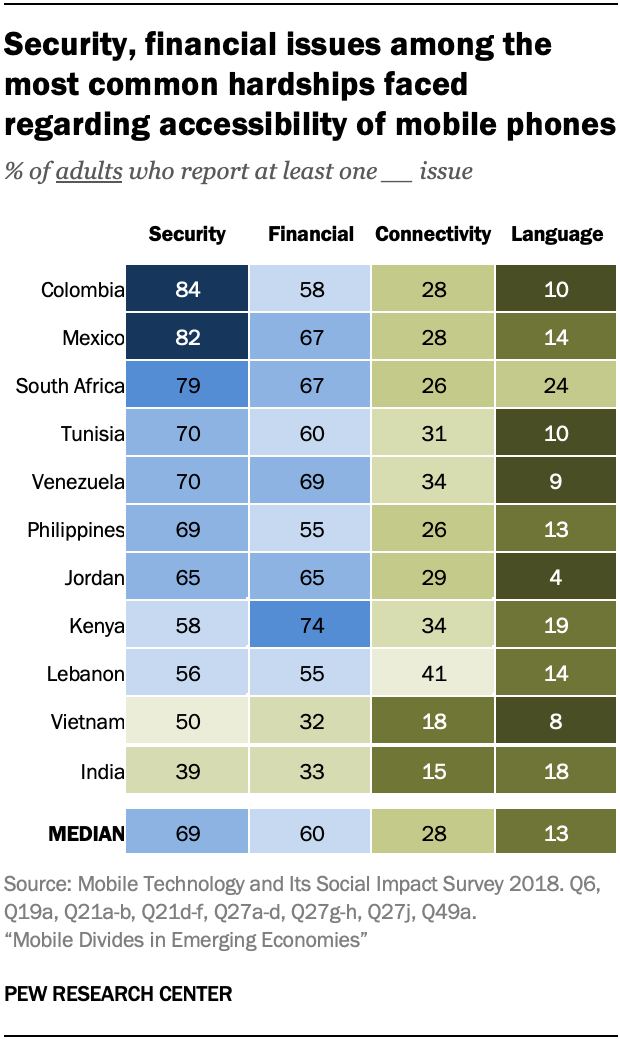
Security-related hardships are relatively common in the 11 emerging economies surveyed, with a median of 69% reporting at least one security hardship. Outside of India, half or more report facing at least one security-related hardship, meaning most individuals are concerned about the security of their information or the physical security of their device. These hardships are especially common in Colombia (84%), Mexico (82%) and South Africa (79%). These countries all rank at or above the median for robbery rates, according to a report from the United Nations Office on Drugs and Crime.
Many individuals also report experiencing financial hardships regarding access to mobile phones (median of 60%). Outside of India and Vietnam, a majority in every country reports experiencing at least one financial hardship. This is highest in Kenya, where 74% of adults report issues affording mobile phones or data.
But while experiencing at least one financial hardship is common, among mobile users, few people experience multiple financial hardships (median of 22%).
Across the 11 countries surveyed, fewer report experiencing a connectivity issue (median of 28%). In every country, fewer than half say they frequently have issues related to reliable service or charging their phone. Connectivity issues are most common in Lebanon, where about four-in-ten adults (41%) report connectivity difficulties.
Most mobile users do not report any connectivity hardships (median 71%). Among those who do have a connectivity hardship, however, few have problems both getting reliable service and charging their phones. Rather, most tend to experience only one of these issues. For example, 66% of mobile phone users in Kenya say they experience no frequent issues, compared with 25% who frequently face one connectivity obstacle and 9% of mobile phone users who say they frequently experience two.
In every country surveyed, only a minority report a language-related issue using their phones (median of 13%). The highest rate of language issues is found in South Africa, where about a quarter (24%) report a language issue. This may be due, in part, to the diversity of languages found in South Africa. As such, some individuals may perceive limited availability of content in their preferred language, even if they are able to read and understand content in other languages.
Smartphone owners experience more security-related concerns
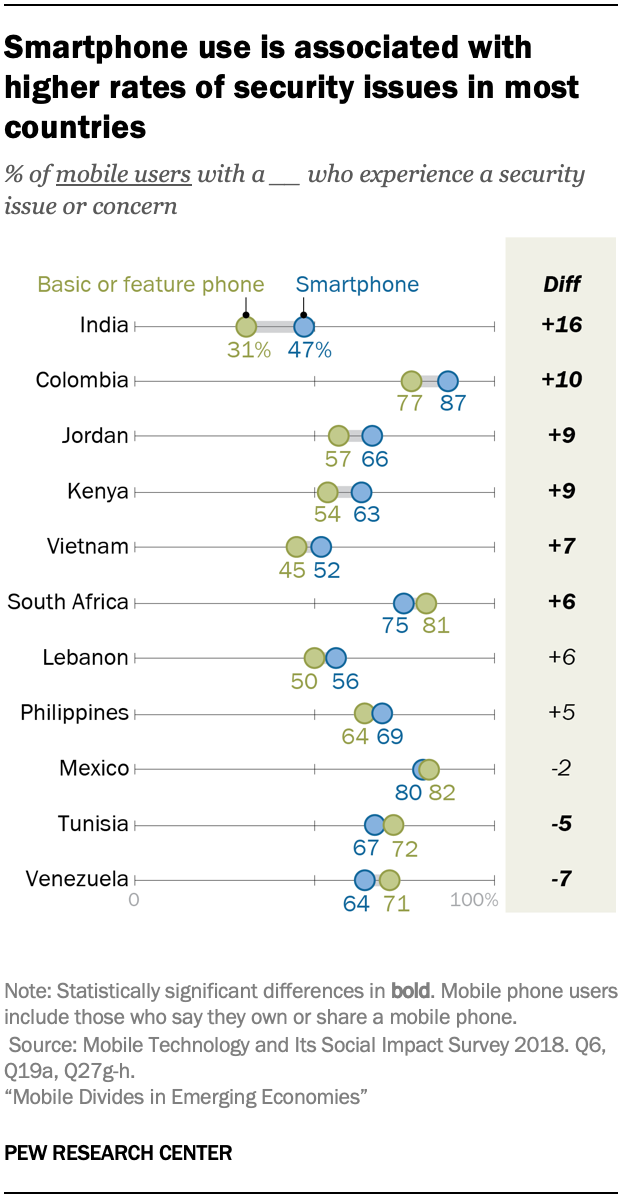
Among mobile phone users, smartphone users are more likely than basic or feature phone users to report a security-related concern. In India, for example, 47% of smartphone users say they worry about security issues, compared with 31% of basic or feature phone users who say the same.
In five countries, those with more education are more likely to report concerns regarding the security of mobile phones and the information they may contain. In Kenya, 69% of individuals with more education report a security issue, compared with 54% of individuals with less education. But, in Tunisia and Venezuela, these patterns are reversed: Those with lower levels of education are more likely to experience a security-related issue.
Those who are lower income face more financial hurdles to mobile technology
Across all 11 countries surveyed, individuals with lower incomes are more likely than those with higher incomes to have a financial difficulty that affects their technological access. For example, 67% of lower-income Lebanese experience a financial issue, compared with 40% of higher-income Lebanese.
You can’t really use your [smart]phone on public transit as it could be stolen. Man, 21, Tunisia
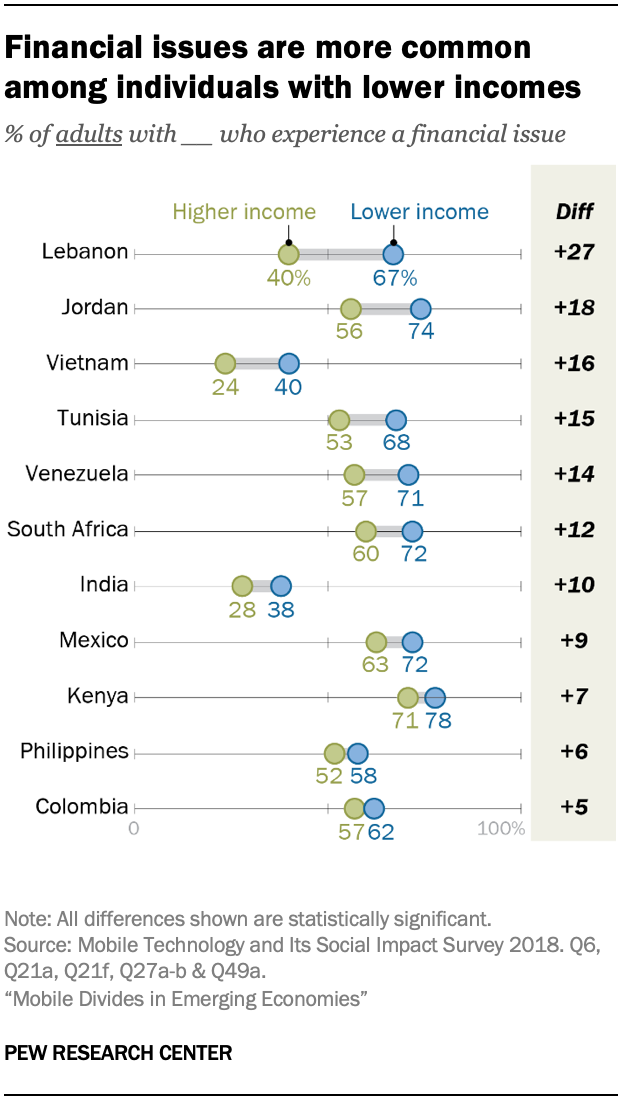
In most countries, younger adults (those ages 18 to 29) are more likely than older adults to report a financial issue. For example, while around half (49%) of South African adults ages 50 and older report financial issues, around three-quarters (77%) of those 18 to 29 say the same.
In six of the 11 nations, those with less education are more likely to experience a financial hardship. Take Jordan as an example: 72% of people with lower levels of education report a financial issue, compared with 58% of those with higher levels of education.
In three countries for which the analysis is possible, mobile phone owners are less likely to report a financial issue than sharers or non-users. The greatest differences are in Venezuela, where 61% of mobile phone owners experience a financial issue, compared with 81% of sharers and 94% of non-users.
When looking at only mobile phone users (both owners and sharers), smartphone users are more likely than those with a basic phone to report a financial issue in most countries. In South Africa, 57% of basic or feature phone users report a financial issue, compared with 71% of smartphone users.
Younger people often have more connectivity-related issues
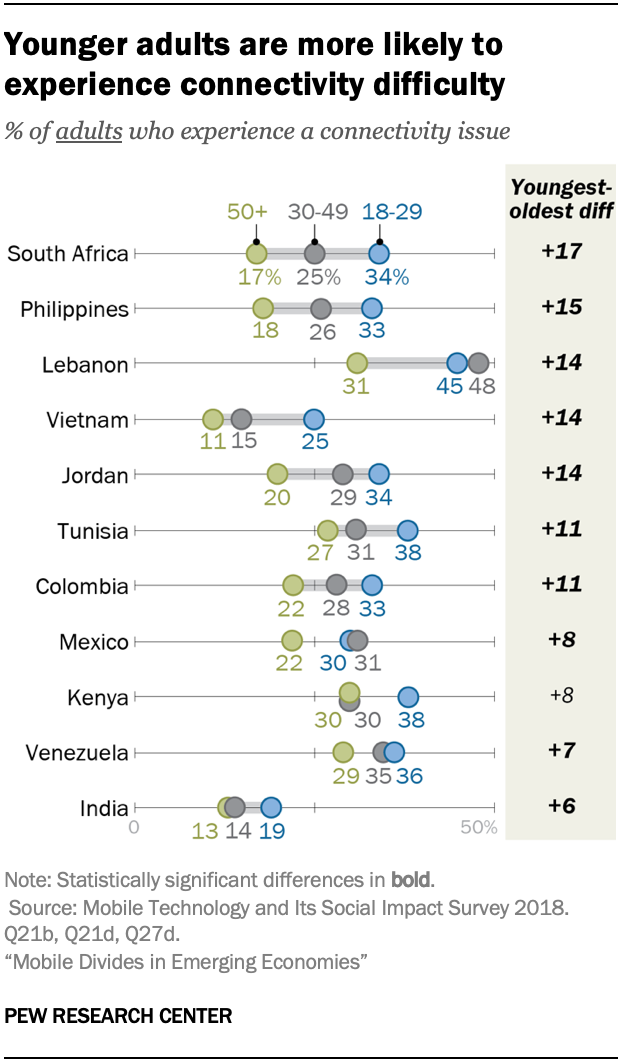
In all countries but Kenya and Lebanon, those ages 18 to 29 are more likely than those 50 and older to report a connectivity issue. For example, about a third of younger Filipinos (33%) have a connectivity issue, whereas 18% of older adults report the same. In contrast, in most countries, gender, income and education have little bearing on whether people experience a connectivity issue.
Those with a smartphone are also more likely to report a connectivity issue than those who use a basic or feature phone in seven of the countries surveyed. For example, in Jordan, 32% of smartphone users experience a connectivity issue, compared with 17% of basic or feature phone users.
I have that behavior where I ask people if I can charge my [smart]phone for two seconds. Woman, 49, Kenya
People with basic English literacy face fewer language-related hardships
In all countries surveyed, experiencing a language-related hardship is relatively uncommon. But, in some countries, those with lower levels of education are more likely to experience this hardship than those with higher levels. For example, 17% of Mexicans with lower levels of education experience a language-related issue, compared with 9% of those with more education.
In six countries, those who can read at least some English are less likely to experience a language-related hardship. For example, in the Philippines, 12% of individuals who can read at least some English say they have a language issue, while nearly twice as many Filipinos who cannot read English report the same (22%).
Non-mobile phone users are more likely than phone sharers or owners to report having a language issue in many countries for which the analysis is possible.4 In Tunisia, for example, 57% of non-users report a language-related issue, compared with 8% of both mobile sharers and owners.
Many people experience concurrent barriers to mobile accessibility
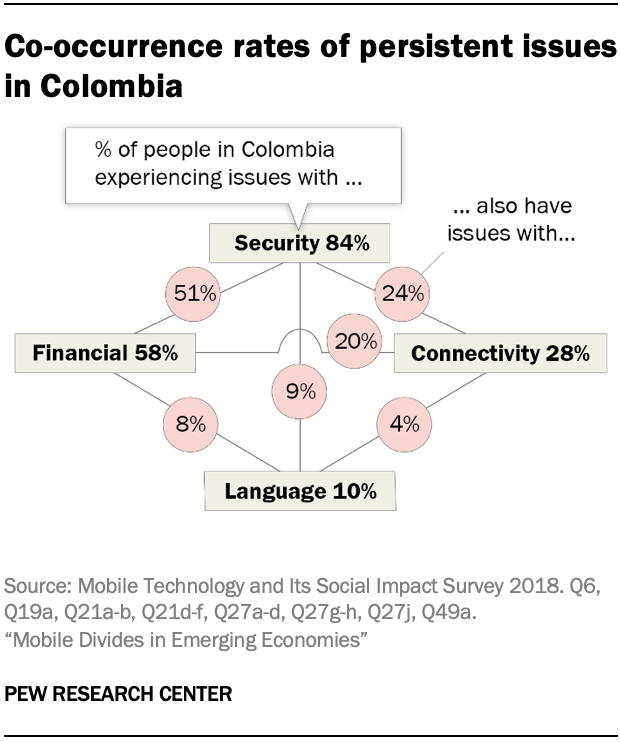
Barriers to mobile use do not occur in isolation. Between 27% and 67% of individuals in each country simultaneously experience two or more types of hardship, and between 1% and 7% of individuals experience all four types of hardship we asked about.
For the two most common hardships – security and financial – between 13% and 56% of individuals in each country surveyed experience both hardships concurrently. For example, roughly half of Colombians (51%) simultaneously experience security and financial issues (for all country-specific numbers, see Appendix C). In fact, aside from India, roughly half or more who experience one of these issues also experiences the other (between 56% and 87%).
[You need an] additional budget because of the load and electricity, because you need to charge it. Before I paid for 100 but now it’s 200 already. Woman, 26, Philippines
Although language issues occur at low rates, individuals in most countries who experience a language-related issue are significantly more likely than those not facing language issues to also face a financial, security or connectivity issue. For example, only 10% of Colombians experience language issues, but the vast majority of that group also experience security issues (overall, this amounts to 9% of the Colombian public who experience both).
Based on statistical analysis that controls for multiple factors concurrently, we find that individuals with higher incomes experience fewer total hardships, whereas smartphone users report experiencing a greater number of hardships. Adults ages 50 and older experience fewer issues than younger adults even after controlling for other demographic factors (for hierarchical linear regression results, see Appendix D).
Difficulties do not shape how people feel about mobile phones in society, but financial difficulties impact perceived personal benefits
Do people who have more difficulty using mobile phones – whether because of costs, service, language or other factors – see them as less beneficial? On the one hand, one might expect that people who have more difficulty using mobile phones could see them as less personally beneficial – and maybe less beneficial to society, as well. On the other hand, those who are endeavoring to use mobile phones – despite the hardships – may be doing so because they see them as more valuable.
Results of this survey suggest that, regardless of hardships associated with mobile phones, people tend to feel similarly about the benefits mobile phones bring to society. In most countries, these evaluations are quite positive. More than half in all countries but Venezuela say that mobile phones have been a good thing for society, ranging from 53% in Jordan 86% in Kenya.
If I pay [for my phone’s] internet, I will get money from there. I will be able to call people from outside and they will give me money. Man, 32, Kenya
Regardless of the type of hardship people face, those who face more challenges accessing mobile phones are still as likely as those facing fewer hardships to see positive societal benefits stemming from digital connectivity.
When asked about specific kinds of impacts mobile phones might have on various aspects of national life, evaluations are more mixed. But these attitudes are not generally colored by whether individuals have difficulties using their mobile phones due to any of the challenges they might have experienced – such as connectivity, financial, security and language. Rather, people who do not face hardships using their phones and those who do tend to feel similarly about how mobile phones impact their country’s economy, education and even children in the country.
Overall, people say mobile phones have been personally beneficial regardless of whether they have experienced hardship in accessing them. Aside from Venezuela, where only around half (49%) see personal benefits, in every other country surveyed, roughly three-quarters or more say they gain personally from mobile devices. When it comes to particular types of personal benefits, though, mobile users who face financial hardships are somewhat more likely to see mobile phones positively impacting them when it comes to obtaining news and information, earning a living, concentrating and getting things done, and communicating face-to face.
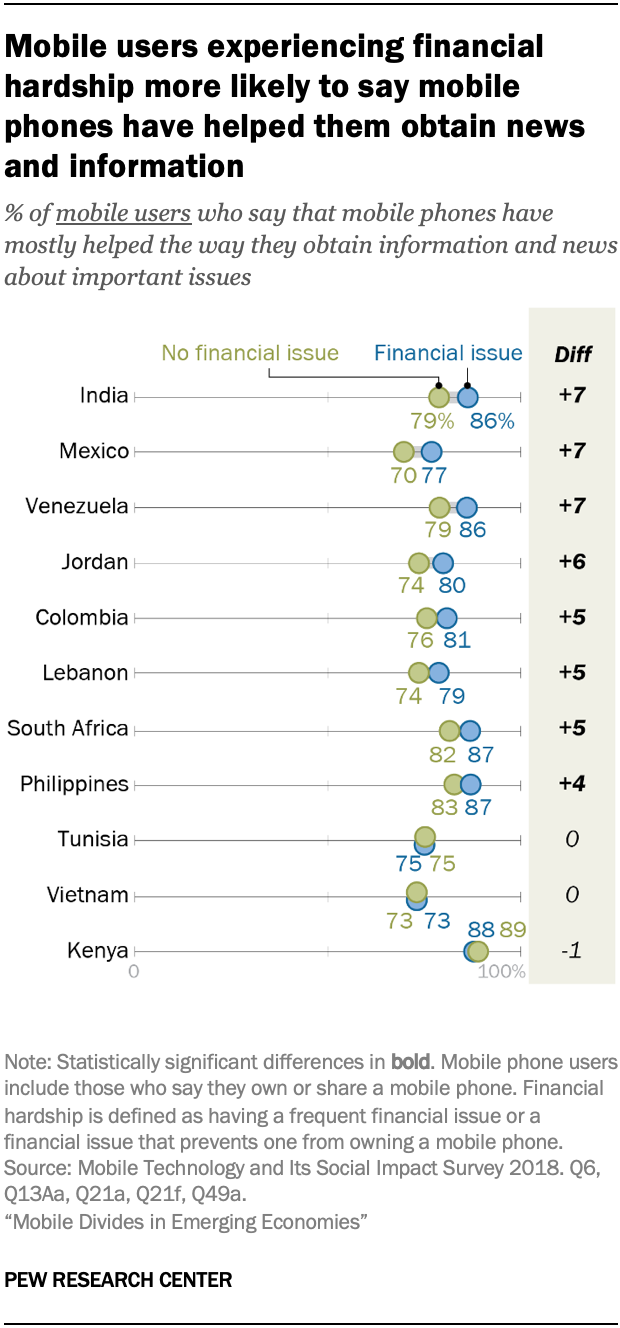
For example, 86% of Venezuelan mobile users reporting a financial issue say that mobile phones help them obtain information and news, compared with 79% of those not reporting a financial issue. Similarly, 73% Indian mobile users who report a financial issue say mobile phones have mostly helped them earn a living, compared with 63% of Indian mobile users who do not report a financial issue.